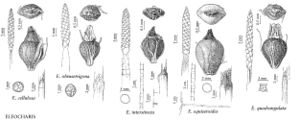Eleocharis obtusetrigona
Syn. Pl. Glumac. 2: 80. 1855.
Plants perennial; rhizomes 3–4 mm thick, soft to hard, longer internodes 3–8 cm, scales more than 1 cm, tubers absent. Culms obscurely 3–5-angled to terete, 40–110 cm × (2–)3.6–7.5 mm, soft, not septate-nodulose, internally spongy, transverse septa incomplete; plants never forming filiform, flaccid culms. Leaves: distal leaf sheaths persistent, membranous, apex acute to long-acuminate, sometimes prolonged into a slender bladelike portion to 6 cm. Spikelets not proliferous, 12–43 × 3.5–6 mm; rachilla joints bearing obscure winglike remnants of floral scales; proximal scale without a flower, amplexicaulous, 3.6–7.5 mm; floral scales 30–125, 1–3 per mm of rachilla, greenish to pale brown, often with pale to dark brown submarginal band or a subapical darker spot, ovate to oblong, 4.3–5.8 × 2.5–3.3 mm, cartilaginous, often membranous toward margins, margins broadly translucent, membranous, apex rounded to acute. Flowers: perianth bristles 6–7, stramineous, margins and spinules reddish to pale brown, stout, flattened, subequal, exceeding achene, 2.5–3.2 mm, coarsely retrorsely spinulose; anthers reddish brown, 1.5–1.9 mm; styles 3-fid or sometimes 2-fid. Achenes pale brown, biconvex, obpyriform, 1.7–2.3 × 1.2–1.5 mm, clearly sculptured at 10–15X, each face with 10–15 rows of transversely elongated cells, often isodiametric at achene base, apex usually constricted to neck 0.5–0.6 mm wide. Tubercles stramineous, lamelliform to high-pyramidal, 0.8–1.1 × 0.7–0.9 mm.
Phenology: Fruiting spring–fall.
Habitat: Fresh, permanent water in ditches
Elevation: 0–20 m
Distribution

Tex., e Mexico, Central America (Nicaragua), South America.
Discussion
In North America Eleocharis obtusetrigona is known from only five collections, two of them originally identified as E. fistulosa (Poiret) Link [= E. acutangula (Roxburgh) Schultes], which is common in Mexico and South America. The original description of E. obtusetrigona is poor and does not clearly distinguish E. obtusangula from E. acutangula. H. K. Svenson (1939) included E. obtusetrigona in E. acutangula, which can be distinguished by its acutely trigonous culms as well as its smaller floral scales and achenes. The tubercles are often spongy as in E. quadrangulata.
Selected References
None.
